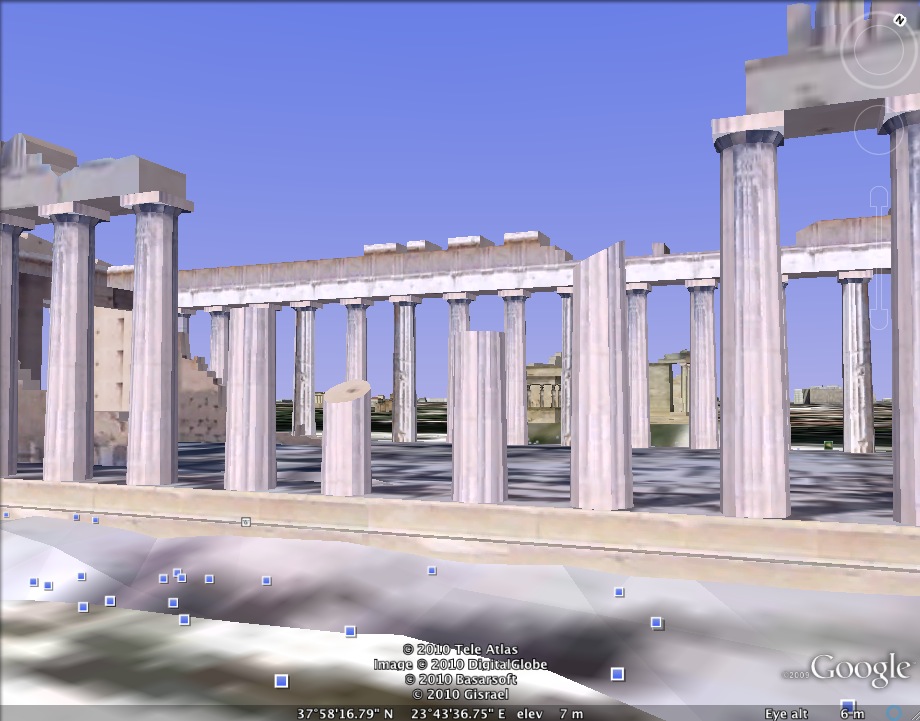
(Image credit: Image capture of the Parthenon in Athens, Greece from Google Earth)
A fellow graduate student recently mentioned to me that his
rhetoric professor had used Google Maps to show classical Athens to the class. He told me, “I kept thinking how much
cooler it would have been if we were looking at it in Google Earth, walking
around down there in street view.”
It’s true. As
shown above, a street view of the Acropolis is, indeed, pretty cool. There is a simple and undeniable “wow”
factor about flying to and viewing sites in Google Earth. But it’s been my contention throughout
these blogs that the use of the Google Earth technology can go beyond the
“that’s so cool” factor and can actually enhance and expand composition
pedagogies. Former DWRLer Jim
Brown (now of Wayne State University) makes this point, too, as he discusses
possible evaluation strategies for Google Maps assignments. Brown writes, “These maps are writing.
They are not just some ‘cool’ thing that will then require a ‘real’ writing
assignment. This assignment should open up important discussions about how
cartography is a form of writing and about how ‘the map is not the
territory.’ Students are creating
something here, not merely reflecting an existing reality” (Brown, “Mapping
Home”).
Brown’s assignment, like most of the assignments I’ve found
so far, asks students to work in Google Maps, not Google Earth. But the writing component is
applicable. The activity he designed, called
“Mapping Home,” asks students
to map key sites in their daily lives, using the map to elucidate the “borders”
that they negotiate or cross regularly.
The link above includes a sample map created by Brown. Using the “My Maps” function in Google
Maps, each of Brown’s students created a individual map with an introduction
and placemarks with text and embedded links, images, or video.
To get the most out of the assignment and to aid evaluation,
Brown encourages instructors to set their expectations about students’ maps:
- How many placemarks should students create?
- What components should placemarks include?
- How much text should placemarks include?
- What components, if any, besides placemarks,
should maps include? (Should they include border lines, connecting lines, or
other vectors, for example?)
- Should the map include an introduction? What should the introduction
accomplish?
- Is an accompanying reflective essay required, or
should the map itself (or an in-class discussion) accomplish the task of
reflection?
Other assignments using Google Maps technology include
Jeremy Dean’s “Map Three Readings,” which asks students to use a map to “draw a physical and thematic
connection” between multiple readings by placing authors or characters on a
map, and Eileen McGinnis’ “Mapping Galapagos,” which asks students to map landmarks and events in Kurt Vonnegut’s
novel, Galapagos. McGinnis frames the map as a thinking process, not a product, at least at the outset: “Keep
in mind that your map will function initially as a tool for discovering
something unexpected about the novel rather than for charting the Known World.”
These assignments demonstrate well how writing within maps
can aid students’ invention process, prompt students to make visual, spatial,
and physical connections within and across texts, and can, themselves,
constitute an argument (thereby denaturalizing mapping as an authorless or
objective rendering of space).
Most of these assignments were created before the release of
Google Earth, however, so they might be adjusted or reformulated to more fully
take advantage of Google Earth’s distinct capacities, such as its capacity to
show non-static data, to depict historical change, to show beautifully-rendered,
3D buildings, to travel from site to site via a user-generated animated tour, to offer
various annotation options via clickable layers, and to move quickly between
macro and micro views of the same landscape. While some
of these features are available in Google Maps, Google Earth’s animation
feature allows users to dramatize these functions, heightening their effect.
Google Earth’s homepage includes a Gallery of selected tours and animations that demonstrate the
technology’s advanced functions.
These animations give a sense of the informational and analytical uses
of features particular to Google Earth, such as 3D buildings, historical
timelines, and the ability to travel. The Gallery includes tours of major world cathedrals, castles, libraries, and universities, as well as an animation of major international flight routes. Each file must be opened within Google Earth, so users must download the software, which is free and available on the same site, to view the demonstrations. It's also important to note that users must find in Google Earth's left-hand sidebar an icon that looks like a movie camera. Clicking this icon will "run" the file.
As I mentioned two weeks ago, the DWRL’s Geo-Everything
Group has been putting together resources to familiarize instructors with
Google Earth and help them integrate it into the writing classroom. Their recent Google Earth Workshop
provided a practical introduction for using Google Earth in the classroom,
including tips for making basic and customized placemarks and using Google’s
data template, Spreadsheet Mapper, for creating collaborative maps with
“branded,” standardized placemarks.
I recommend taking a look at their Google Earth Workshop handout for practical guidance to getting started in Google Earth.
Comments
Geo-Everything Rocks!
As a RHE student, I'm fascinated by the Geo-Everything Project.
I was lucky enough to sit in on the Google Earth workshop. Watching a timelapse of the Palace and cathedral in Haiti gave a powerful experience of the destruction caused by the quake.
We also created a tour of New York led by Jay Z!
I recommend everyone check out the Google Earth Workshop. There's clear instructions on how to create tours and explore the digital world.